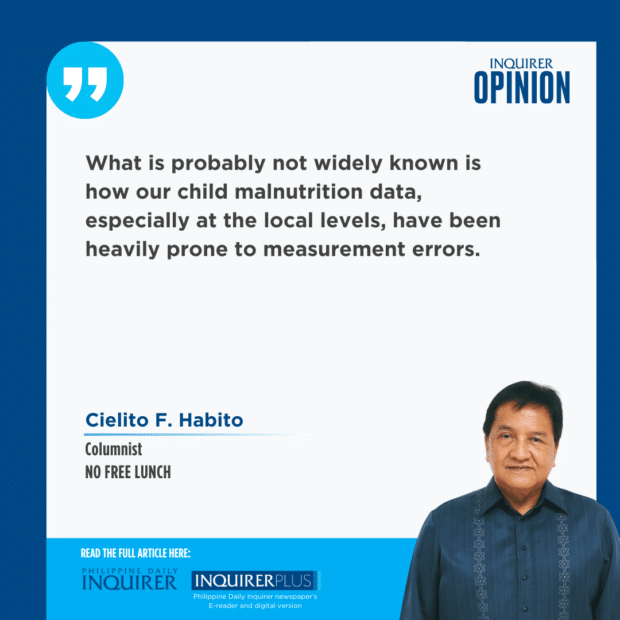Mismeasuring malnutrition

It’s now widely known how severe malnutrition stunts the physical and mental development of one in every three Filipino children under 5 years old, and how this contributes to our schoolchildren having among the worst, if not the worst performance worldwide. What is probably not widely known is how our child malnutrition data, especially at the local levels, have been heavily prone to measurement errors.
I learned much in a recent talk with a public nutrition expert who has actively helped our nutrition authorities assess the state of malnutrition in the country for years, and find ways to improve the accuracy and reliability of the data. He cites three key elements in public nutrition assessment—the people who do it; the tools they use to gather, compile, and process the data; and the methods they employ in the conduct of the measurements and assessments. The bad news is that there are major problems with all three. The good news is that things have improved with fixes being done, with our expert (who happens to be my brother Dr. Raymundo Celestino Habito Jr.) being instrumental in introducing them.
On people, those tasked with measurement at the local level—the Barangay Nutrition Scholars (BNS)—are severely overworked and grossly underpaid. Their name is a misnomer; they are not students being supported in their studies, but volunteer workers who receive no formal wages. All they get are small allowances, originally set at P150 per month by Presidential Decree No. 1569 that established the BNS system; now it’s about P500, plus whatever additional amount their respective barangay or municipal government gives them. It’s a pittance in return for the hard work they do, which PD 1569 defines to include “delivering nutrition services and other related activities such as community health, backyard food production, environmental sanitation, culture, mental feeding, and family planning to the barangay.” Just the annual nutritional assessment of all children under 5 years old, taken at the start of every year under the National Nutrition Council’s (NNC) Operation Timbang (OPT), tasks them to measure the weight and height of every child in their barangay. A major problem is that many admit to feeling pressured to show good numbers (otherwise, “magagalit si Mayor”), which only makes it harder to effectively address the problem if the local authorities are in denial.
On tools, there are two kinds: physical measurement tools, and data entry and processing tools. In the early years of OPT, weighing scales used included traditional hanging rod-type market scales, which proved dangerous (children were prone to falling while being weighed); or simple bathroom scales, which have questionable accuracy. Each child’s information on birthdate, weight, and height was recorded manually on paper forms. Local governments have since been led and assisted in using the prescribed Salter scales for standardization and accuracy. NNC has introduced an electronic spreadsheet-based tool (called e-OPT Plus) to automate the tabulation and processing of the children’s weight, height, and age data, vastly raising the quality of OPT data—but also leading to worse malnutrition figures. I’m told that automated calculation of a child’s age in months from the birthdate and current date revealed errors in up to 40 percent of the manually derived age data entries. More often than not, manual calculation underestimated the children’s ages, thus also underestimating the actual extent of stunting.
Lastly, the method of measurement also greatly impacts accuracy. Up to 2 years old, a child’s height has to be measured lying down, and whether the knees are bent or held straight, or whether they are struggling and crying or staying still, greatly affects the accuracy of the height measured. Creative BNS may “gamify” the measurement process to make the child cooperative. Ideally, OPT should cover at least 75 percent of the target children, if 100 percent is impossible. But in many barangays, the BNS could only achieve much less, unable to reach children in remote areas in the uplands and small islands, or in large houses with closed gates. The lower the coverage, the less accurate the nutrition picture that the limited data would paint.
On the other hand, our “gold standard” nutrition data come from the Food and Nutrition Research Institute’s National Nutrition Survey, which is conducted by trained nutritionists, but only done nationwide every five years. But it surveys only a sample rather than all children within the target age group, so it cannot reliably break down malnutrition figures at the municipal or city levels. But the war on malnutrition is best fought down at the grassroots level, and for as long as our mayors are unable, or even refuse, to know the true picture, effective solutions will not be forthcoming.
cielito.habito@gmail.com




















